Identification of genes periodically expressed in the human cell cycle and their expression in tumors
- PMID: 12058064
- PMCID: PMC117619
- DOI: 10.1091/mbc.02-02-0030
Identification of genes periodically expressed in the human cell cycle and their expression in tumors
Abstract
The genome-wide program of gene expression during the cell division cycle in a human cancer cell line (HeLa) was characterized using cDNA microarrays. Transcripts of >850 genes showed periodic variation during the cell cycle. Hierarchical clustering of the expression patterns revealed coexpressed groups of previously well-characterized genes involved in essential cell cycle processes such as DNA replication, chromosome segregation, and cell adhesion along with genes of uncharacterized function. Most of the genes whose expression had previously been reported to correlate with the proliferative state of tumors were found herein also to be periodically expressed during the HeLa cell cycle. However, some of the genes periodically expressed in the HeLa cell cycle do not have a consistent correlation with tumor proliferation. Cell cycle-regulated transcripts of genes involved in fundamental processes such as DNA replication and chromosome segregation seem to be more highly expressed in proliferative tumors simply because they contain more cycling cells. The data in this report provide a comprehensive catalog of cell cycle regulated genes that can serve as a starting point for functional discovery. The full dataset is available at http://genome-www.stanford.edu/Human-CellCycle/HeLa/.
Figures










Comment in
-
It's the data!Mol Biol Cell. 2010 Jan 1;21(1):4-6. doi: 10.1091/mbc.e09-07-0575. Mol Biol Cell. 2010. PMID: 20048255 Free PMC article.
References
-
- Abrieu A, Kahana JA, Wood KW, Cleveland DW. CENP-E as an essential component of the mitotic checkpoint in vitro. Cell. 2000;102:817–826. - PubMed
-
- Abrieu A, Magnaghi-Jaulin L, Kahana JA, Peter M, Castro A, Vigneron S, Lorca T, Cleveland DW, Labbe J. Mps1 is a kinetochore-associated kinase essential for the vertebrate mitotic checkpoint. Cell. 2001;106:83–93. - PubMed
-
- Adolph KW, Phelps JP. Role of non-histones in chromosome structure. Cell cycle variations in protein synthesis. J Biol Chem. 1982;257:9086–9092. - PubMed
-
- Alizadeh AA, et al. Distinct types of diffuse large B-cell lymphoma identified by gene expression profiling. Nature. 2000;403:503–511. - PubMed
Publication types
MeSH terms
Substances
Grants and funding
LinkOut - more resources
Full Text Sources
Other Literature Sources
Molecular Biology Databases

